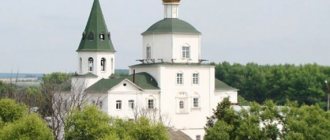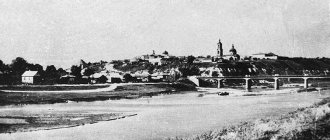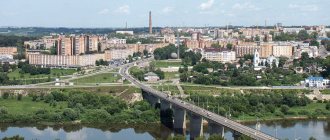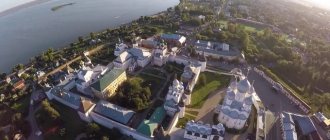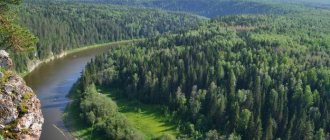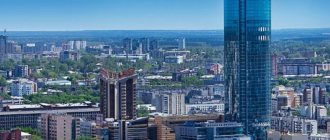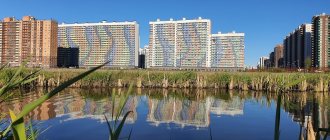Kuban is the largest river in the North Caucasus. The Bolshoy Zelenchuk River flows into it. A large cape formed at the confluence. It was on it that Nevinnomyssk was founded. This situation is reflected in the city coat of arms - two blue stripes converge on a golden field, forming a green triangle. The city is the starting point for many tourist routes in the North Caucasus.
Coat of arms of Nevinnomyssk
On the Innocent Cape
The city of Nevinnomyssk is located in the Ciscaucasia, 70 kilometers south of Stavropol. From a geographical point of view, the area is called the Stavropol Upland. Urban development stretches along the left bank of the Bolshoi Zelenchuk River and the right bank of the Kuban River. The internal floodplain area between the rivers is not built up and is a forested area. This is a favorite vacation spot for city residents.
There are two main versions regarding the history of the origin of the city's name. The first belongs to the military historian Vasily Potto. More than a hundred years ago, he studied the Mozdok archive and discovered a circular dated 1784. It followed from it that the river flowing into the Kuban was ordered to be called Innocent. It already had a name given by the soldiers, but it sounded obscene. Later, a village was founded on the cape, at the confluence of the Nevinnaya River and the Kuban. The name Nevinnomyssk was assigned to it.
The author of the second version is the Stavropol local historian V. Kolesnikov, who wrote the book “The Past of the Innocent Cape”. In his opinion, the name of the settlement was given by Count Pavel Potemkin in 1784. The reason was the nearby mountain "Aryuv-kyz". Translated from Nogai it means “beautiful girl”. There is a legend associated with the mountain, according to which an innocent girl died after being married to an unloved man.
Memory of the heroes of distant battles
A monument to General Ermolov, a participant in the wars with France in 1805, 1812 and military operations in the Caucasus, was erected.
The talented commander was both a wise politician and an active reformer. Heading the military forces of the Caucasian Corps, he did a lot for the reconciliation and development of these regions.
In 1918, Ivan Kochubey, having gathered a detachment of poor Cossacks, fought his way to the Tikhoretsk station, where he was enlisted in the Red Army. He led his detachment into battle against the White Guards in the North Caucasus. A talented organizer, he carried out brilliant military operations against the units of Shkuro, Pokrovsky, and Erdeli. Died at age 26. In 1959, a monument was erected to him, which is considered a landmark of the city of Nevinnomyssk.
Kingdom of water and greenery
Summers in Nevinnomyssk are hot and winters are mild. This climate is called temperate continental. Since there is a lot of water and heat here, the surroundings of the city are surrounded by greenery. The most precipitation falls in May, June and August. The least is in January and February. The hottest period is July-August. The air at this time warms up to +28 degrees. It is coldest from December to February, but the cold here is conditional, since the temperature fluctuates around zero. In the coldest years it did not fall below -7 degrees.
City outskirts
The city is crossed by two waterways - Kuban and Bolshoy Zelenchuk. The length of Kuban reaches 870 kilometers! It originates on Elbrus in Karachay-Cherkessia and carries its waters to the Sea of Azov. It’s hard to believe, but along its entire length, 14 thousand large, small and very small tributaries flow into the river! It is curious that after Nevinnomyssk the right tributaries completely disappear. The width of the river in the urban area reaches from 50 to 100 meters. There are several large islands in the channel. The largest has dimensions of 1800x500 meters.
The Bolshoi Zelenchuk River is significantly inferior to the Kuban. Its length is only 158 kilometers. It originates near the village of Arkhyz and flows into the Kuban in Nevinnomyssk. In the upper reaches, along the left bank, stretches the Teberda Nature Reserve. On the river there is the Zelenchukskaya hydroelectric station, which is considered the largest in the North Caucasus. The earthen dam is 670 meters long and 12 meters high. The hydroelectric complex forms a small reservoir. The width of the river within Nevinnomyssk ranges from 20 to 100 meters.
Those who fell in the Great Patriotic War
The largest number of attractions in Nevinnomyssk are dedicated to the brutal war that split the life of Soviet people into “before and after.” In 1967, the Eternal Glory monument opened in the city center. It is dedicated to all the soldiers who did not return from the two world wars. A snow-white stele flew up, at the foot of which the Eternal Flame burned. A commemorative capsule containing the soil that was defended by the fallen soldiers was placed into the monument. A handful of it was brought from places of heroic heavy battles: from Mamayev Kurgan from Volgograd, from the Brest Fortress, from Malaya Zemlya near Novorossiysk.
For the 55th anniversary of the Great Victory, a Book of Memory was installed next to the stele, creating a memorial complex. 3 meters high and 13 meters wide, it contains 4003 names of Innocent Myssians who died in battle or went missing on the fields of the Patriotic War.
From antiquity to modern times
The favorable climate has attracted people to these places since ancient times. Cattle breeders especially loved them. Archaeologists have discovered many traces of sites and settlements of the Scythians, Khazars, Sarmatians and Alans. The Huns, Avars, Cumans, Pechenegs and Mongols lived here. Such an active life of various peoples is explained by the fact that one of the branches of the Great Silk Road passed through these regions. It went from the lower reaches of the Volga to the Black Sea, where the ports were located.
In the second half of the 18th century, the territory was part of the Crimean Khanate. In 1778 it became part of the Russian Empire. The border moved to the east and a small fortification was built on the cape, at the confluence of two rivers. The cape rose above the valley, so the surroundings were visible from it. Military skirmishes took place at the redoubt several times, in which Russian and Circassian troops took part. The village of Nevinnomysskaya was officially founded in October 1825.
Archaeologists have discovered many traces of the activities of ancient peoples
In the middle of the 19th century, the village was visited by Grand Duke Alexander Nikolaevich, who later became Emperor Alexander II. The construction of the railway caused a real industrial boom. The largest steam mill in the North Caucasus and the largest wool washing factory in the country appeared. The Church of the Intercession of the Blessed Virgin Mary was built in the village, a school and the first cinema were opened. The population increased rapidly.
After the October Revolution, the workers of the village took an active part in the establishment of Soviet power. The civil war tore Nevinnomyssk into two irreconcilable parts - the workers fought against the Cossacks. In the 1920s, the village experienced a terrible famine and repression. Just before the war, they almost managed to build the 50-kilometer-long Nevinnomyssk Canal. It was supposed to serve to irrigate the lands of Stavropol and protect the region from drought. Later, two hydroelectric power stations were built on the canal.
This is what the city looked like more than 100 years ago
During the war the city was occupied by the Germans. After the liberation, it was decided to turn Nevinnomyssk into the largest center of the chemical industry. The city-forming enterprise was the Nevinnomyssk Azot plant. The company still produces ammonia, nitrate, urea, nitrogen fertilizers, dry ice, acetic acid and many other useful substances. Factories for household chemicals and electrical measuring instruments, as well as a worsted spinning factory, appeared in the city.
The beginning of the 21st century was not entirely successful for the city. In 2002, the worst flood in a hundred years occurred. It destroyed all bridges across the Kuban and flooded coastal areas. Four years later, a giant hail fell. The weight of hailstones reached 100 grams! Then there was an earthquake and civil unrest, the cause of which was ethnic crime.
The city-forming enterprise is the Nevinnomyssk Azot plant.
In 2021, Nevinnomyssk was included in the Guinness Book of Records. On the bridge across the Kuban, 4,573 people simultaneously stood in the plank! In physical education, a “plank” is the push-up position. The arms should be straight in it. The participants of the unusual action stood in this position for one minute.
The starting location cannot be changed
Numerous walking routes around the North Caucasus begin in Nevinnomyssk. From here hikes to the villages of Arkhyz and Teberda and the Sofia Lakes start. To get to the lakes of the Teberdinsky ridge, from the city they first go to the village of Kardonikskaya. In its vicinity there is a recreation center Kishket.
Numerous walking routes in the North Caucasus begin in Nevinnomyssk
Since Nevinnomyssk is a large industrial center, industrial tourism is actively developing here. Such excursions will certainly interest the inquisitive and curious. For example, you can see how aerosol cans are “blown” from an aluminum billet. Half of the cans produced in Russia are made here.
Excursions are organized to industrial enterprises
In the future, there should be excursions to the Kazminsky dairy plant, where natural dairy products are produced, as well as to a chocolate factory. Directly below the city there is a whole lake of thermal mineral water. Thanks to this, a balneological resort should appear in the city. There is a reindeer farm for one hundred animals. Reindeer antlers will be used at the resort to prepare antler baths.
You can skate at the Olympic Ice Palace all year round. The Sherstyanik House of Culture is located in a historical building. Back in 1895, it was built by the merchant Lapin. It has remained unchanged to this day. The same merchant founded the Sherstyanik park. It has many interesting monuments and wooden sculptures. Unusual names appeared thanks to the old wool factory. There are more than a dozen hotels in Nevinnomyssk. The largest are “Kuban”, “Kolos” and “Zelenaya”.
What to see
The city has a local history museum, established in 1957. There are five Orthodox churches, including the Cathedral of the Intercession of the Blessed Virgin Mary and the Temple of Our Lady of Kazan. These are the oldest churches. The Temple of Seraphim of Sarov was built in 2015. Back in the 18th century, a source was discovered, which was given the name of Seraphim of Sarov. Now it is located on the territory of the Ion-Mariinsky Monastery. He was imprisoned in an artificial grotto. The water from it is considered healing.
It is worth visiting the Central Park of Culture and Leisure, where there are attractions. Its main asset is the chestnut alley. When it was formed, several trees were merged into one, so they look very unusual. The park has two large ponds located along the right bank of the Kuban. On the shore of one of them there is an observation deck and a beach.
The main asset of the park is the chestnut alley
Among the townspeople, the pedestrian Boulevard of Peace, which leads to Central Park, is considered a favorite place for walking. It is paved with multi-colored stone tiles and has a length of 900 meters. The boulevard is decorated with a fountain. In the historical part of the city you can see old adobe houses from the beginning of the last century with a typical hipped roof.
In total, there are 15 monuments in Nevinnomyssk. Most of them are dedicated to revolutionary events and the period of the Great Patriotic War. The depot where the Kommunist armored train was built during the Civil War has been preserved. The monument to the Khoper Cossacks was erected in the place where, more than 170 years ago, 17 Cossacks who died defending the village from the highlanders were buried. The city even has a monument... to glasses!
There are pike perch in the canal
The Nevinnomyssk Canal can be considered an attraction in the outskirts of the city. Through it, water from the Kuban flows into the Yegorlyk River. Construction of the canal began before the war, and it was put into operation in 1948. It originates near Nevinnomyssk, where the Kuban is blocked by a dam. Water, first of all, enters the Sengileevskoye reservoir. These places are good for fishing. Here you can find pike perch, silver carp, perch, chub, grass carp - a total of 34 species of fish!
A natural attraction is Mount Nevinskaya. It can be identified by the cross at the top. It’s worth climbing here to see the panorama of the city and the valley of the Kuban River. In the center of Nevinnomyssk the Intercession Cathedral is clearly visible. In clear weather, Elbrus can be seen from the southeast side. In the north rises Strizhament - the highest mountain of the Stavropol Plain.
In the old days, Nevinskaya Mountain was called “Aryuv-kyz”. At the end of the 18th century there was a guard post at the top. Then there was a wooden observation tower on which was attached a pole wrapped in tow soaked in resin. If a signal was required, it was set on fire. You can climb the mountain on foot from an area called ZIP. Several minibuses go here from the center. You will have to sweat while climbing, but the result is worth it.
There is a thermal complex in the vicinity of Nevinnomyssk
To the west of Nevinnomyssk is the village of Kazminskoye. It is famous for its sodium bicarbonate thermal springs. Water has healing properties. The thermal complex “Valley of Geysers” operates on the basis of the springs. There is a huge swimming pool in the open air. There is a hotel. Swimming in the pool is not only pleasant, but also useful. Local water, in particular, has a healing and rejuvenating effect.
Spare parts
In 1972, a plant for the production of measuring instruments, abbreviated ZIP, was built on the outskirts of the city.
Gradually, residential areas were built around the plant, and the area received the same name: ZIP.
How to get there
You can come here by buses No. 6,8,14,19,21 to the stops “6th Microdistrict” and “Apanasenko Street”. There are no direct routes from the bus and train stations.
What to look at
To be honest, it’s not worth going to the ZIP area for sightseeing. Because they simply aren’t here. Unless you look at the Kvant building (the current name of ZIP) or see up close the most recognizable landmark of Nevinnomyssk - Nevinskaya Mountain with a 10-meter Orthodox cross on top.
If you get hungry, on the street. Apanasenko, 76 there is a cafe “Ark” with Armenian cuisine. The approximate cost of lunch here is 500-1500 rubles.
Where to stay
The area is very remote from the city center, so it is better to find accommodation closer. However, here you can rent an apartment for 800-900 rubles per day. There are no hotels here.


